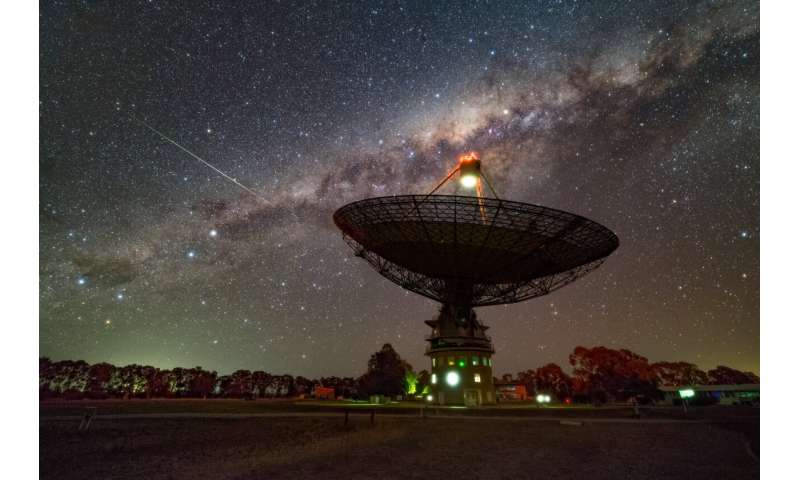Researchers using Murriyang, CSIRO’s Parkes radio telescope, have detected unusual radio pulses from a previously dormant star with a powerful magnetic field.
The paper, “Linear to circular conversion in the polarized radio emission of a magnetar,” published in Nature Astronomy describe radio signals from magnetar XTE J1810-197 behaving in complex ways.
Magnetars are a type of neutron star and the strongest magnets in the universe. At roughly 8,000 light years away, this magnetar is also the closest known to Earth.
Most are known to emit polarized light, though the light this magnetar is emitting is circularly polarized, where the light appears to spiral as it moves through space.
Dr. Marcus Lower, a postdoctoral fellow at Australia’s national science agency—CSIRO, led the latest research and said the results are unexpected and totally unprecedented.
“Unlike the radio signals we’ve seen from other magnetars, this one is emitting enormous amounts of rapidly changing circular polarization. We had never seen anything like this before,” Dr. Lower said.
Dr. Manisha Caleb from the University of Sydney and co-author on the study said studying magnetars offers insights into the physics of intense magnetic fields and the environments these create.
“The signals emitted from this magnetar imply that interactions at the surface of the star are more complex than previous theoretical explanations.”
Detecting radio pulses from magnetars is already extremely rare: XTE J1810-197 is one of only a handful known to produce them.
While it’s not certain why this magnetar is behaving so differently, the team has an idea.
“Our results suggest there is a superheated plasma above the magnetar’s magnetic pole, which is acting like a polarizing filter,” Dr. Lower said.
“How exactly the plasma is doing this is still to be determined.”
XTE J1810-197 was first observed to emit radio signals in 2003. Then it went silent for well over a decade. The signals were again detected by the University of Manchester’s 76-m Lovell telescope at the Jodrell Bank Observatory in 2018 and quickly followed up by Murriyang, which has been crucial to observing the magnetar’s radio emissions ever since.

Murriyang, CSIRO’s Parkes radio telescope beneath the Milky Way. © Alex Cherney/CSIRO

Murriyang, CSIRO’s Parkes radio telescope in the field with wild kangaroos. © CSIRO

Artist’s impression of a magnetar with magnetic field and powerful jets. © CSIRO
The 64-m diameter telescope on Wiradjuri Country is equipped with a cutting-edge ultra-wide bandwidth receiver. The receiver was designed by CSIRO engineers who are world leaders in developing technologies for radio astronomy applications.
The receiver allows for more precise measurements of celestial objects, especially magnetars, as it is highly sensitive to changes in brightness and polarization across a broad range of radio frequencies.
Studies of magnetars such as these provide insights into a range of extreme and unusual phenomena, such as plasma dynamics, bursts of X-rays and gamma-rays, and potentially fast radio bursts.
More information:
Linear to circular conversion in the polarized radio emission of a magnetar, Nature Astronomy (2024). DOI: 10.1038/s41550-024-02225-8
Citation:
Astronomers detect unprecedented behavior from nearby magnetar (2024, April 8)
